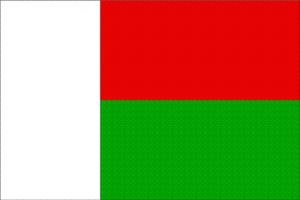Language/Plateau-malagasy/Vocabulary/Clothes
Hi Plateau Malagasy learners! 😊
In this lesson, we will be learning about Plateau Malagasy vocabulary related to clothes. Clothing is an essential part of our daily life, and knowing the names of different clothes and accessories is useful while shopping or describing outfits. By the end of this lesson, you will be able to identify most common types of clothes and accessories in Plateau Malagasy. Let's get started!
Don't hesitate to look into these other pages after completing this lesson: Plateau Malagasy Vocabulary → Greetings and Introductions ..., Colors, Common Food Items & Travel Phrases and Directions.
Vocabulary[edit | edit source]
Here are some common Plateau Malagasy words for different types of clothes and accessories:
| Plateau Malagasy | Pronunciation | English |
|---|---|---|
| safaly | sa-fa-ly | Hat |
| lambo | lam-bo | Scarf |
| sari | sa-ri | Sari |
| salovana | sa-lo-va-na | Shirt |
| volo | vo-lo | Pants |
| sandaly | san-da-ly | Sandals |
| kapy | ka-py | Cape |
| tsiriky | tsi-ri-ky | Skirt |
| vata | va-ta | Belt |
| sabatra | sa-ba-tra | Shoes |
| salamo | sa-la-mo | Dress |
| sabolo | sa-bo-lo | Boots |
| kalobary | ka-lo-ba-ry | Coat |
| kaloty | ka-lo-ty | Shorts |
| singiny | sin-gi-ny | Socks |
| safidy | sa-fi-dy | Tie |
| enjana | en-ja-na | Jacket |
| boky sy kapa | bo-ky sy ka-pa | Backpack |
Take some time to practice the pronunciation of these words. To improve your Plateau Malagasy vocabulary, you can also use the Polyglot Club website. Find native speakers and ask them any questions!
Dialogue[edit | edit source]
Here's a short dialogue to help you practice the new vocabulary:
- Person 1: Njaka, azo antokaiko hoe misy (salamo) iray any an-dohalika?
- Person 2: Eny aho, rehefa ela taona ny adiny dia mety hankany amin'ny (kalobary) matetika.
- Person 1: Ah, ary ny sakafo?
- Person 2: Mbola tsy nifandimby aho, noho izany dia tsy tafiditra amin'ny (vata) irery ry zalahy.
- Person 1: Tsy mahazo (volo) ve ianao amin'ny fiainam-pirenena?
- Person 2: Efa nomena ny ankizy ny volo fa tsy ampy iray izahay, fa mety ho azo avy eo amin'i Dada.
- Person 1: Njaka, can you tell me where I can buy a (dress) for the party?
- Person 2: Sure, you can go to the mall, they have many (coats) and (dresses).
- Person 1: Okay, how about shoes?
- Person 2: I haven't bought new shoes for a long time, so I need to buy a (belt) first.
- Person 1: Don't you have enough (pants) for everyday life?
- Person 2: I've already given my pants to my kids, we only have one pair, but we can borrow from Dada.
Culture and Interesting Facts[edit | edit source]
In Plateau Malagasy culture, clothing plays an important role in expressing one's identity and social status. For example, during traditional ceremonies or events, people wear traditional clothes like the sari for women and the safidy and salovana for men. The patterns and colors of these traditional clothes usually represent specific meanings related to the occasion or one's social standing.
Another interesting fact about clothing in Plateau Malagasy is that people often wear sandals or flip flops as everyday footwear, even in the rainy season. This is because the climate is warm and humid and it's practical to wear light and breathable shoes. However, during colder months, people wear boots or closed shoes to keep their feet warm and dry.
Now that you have learned some valuable vocabulary related to clothes, it's time to practice and try using them in your daily life. This knowledge will help you better communicate with Plateau Malagasy speakers and appreciate their culture. Don't forget to check out our Plateau Malagasy vocabulary section for more useful words.
➡ If you have any questions, please ask them in the comments section below.
➡ Feel free to edit this wiki page if you think it can be improved. 😎

